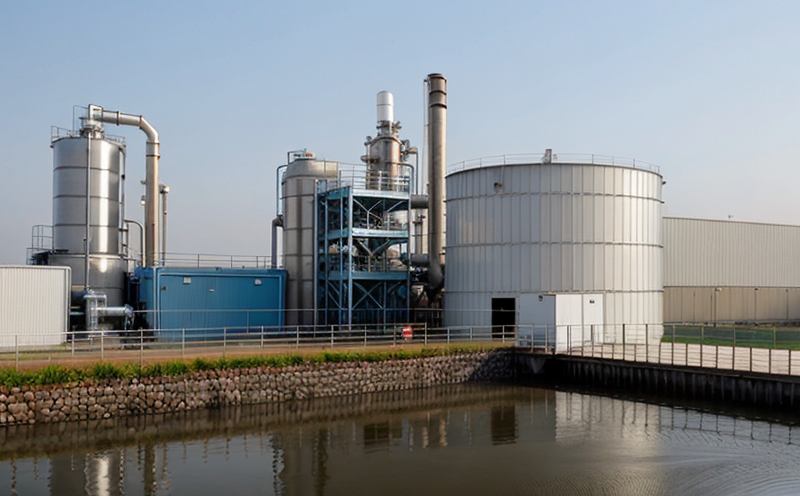ISO 10870 Ecotoxicity Testing of Industrial Wastewater
The ISO 10870 standard provides a framework to assess the potential ecological risks posed by industrial wastewater. This is crucial for ensuring that discharges meet regulatory and environmental protection standards, safeguarding aquatic ecosystems and human health. The test measures the acute toxicity of industrial wastewaters towards freshwater organisms such as Daphnia magna (water fleas) or fathead minnows.
Industrial manufacturing processes generate significant volumes of wastewater. This waste can contain a variety of pollutants including heavy metals, organic compounds, salts, and other chemicals. Without proper treatment, these contaminants could be released into the environment, causing harm to aquatic life and potentially violating environmental regulations. ISO 10870 helps prevent such risks by providing a standardized method for measuring toxicity.
The testing process involves several steps: sample preparation, exposure of test organisms to wastewater samples under controlled conditions, observation of mortality or behavioral changes over time, and statistical analysis of results. Compliance with this standard ensures that industrial facilities can demonstrate their commitment to sustainable practices and environmental stewardship.
Industrial water management is a critical component of any manufacturing operation. By adhering to ISO 10870 standards for ecotoxicity testing, companies not only meet regulatory requirements but also enhance their reputation as responsible stewards of the environment. This can lead to better stakeholder relations and improved operational efficiency.
For instance, a large petrochemical plant might generate millions of gallons of wastewater daily. Regularly conducting ISO 10870 tests helps identify any emerging issues early on, allowing for proactive adjustments in treatment processes. Similarly, food processing plants must ensure their effluents do not contain harmful levels of nitrates or pesticides which could contaminate local water bodies.
The results from these tests are essential inputs into decision-making around wastewater treatment technologies and operational practices. They help prioritize investments in advanced filtration systems, biological treatments, or other methods that can reduce the toxicity of effluent streams before they leave the facility.
Furthermore, compliance with ISO 10870 enhances an organization's ability to adapt to changing environmental regulations. As governments around the world strengthen their stance on pollution control, having robust data from ecotoxicity tests allows industries to anticipate new requirements and implement necessary changes ahead of time.
Scope and Methodology
| Test Procedure | Expected Outcomes |
|---|---|
| Sample Collection and Preservation | Achieving representative samples for analysis |
| Preparation of Test Solutions | Maintaining stable conditions conducive to organism health |
| Exposure Experiments with Freshwater Organisms | Evaluating survival rates and behavior changes |
| Data Analysis Using Statistical Methods | Determining the EC50 value (median lethal concentration) |
| Equipment Requirements | Description of Equipment |
|---|---|
| Water Flea Incubation Chamber | A specialized chamber designed to maintain optimal temperature and humidity levels for Daphnia magna. |
| Automated Recording System | To continuously monitor and record any observable changes in the test organisms' behavior during exposure. |
| Statistical Software | For accurate calculation of EC50 values based on observed mortality rates. |
The ISO 10870 protocol specifies detailed procedures for collecting and handling wastewater samples. It emphasizes the importance of preserving sample integrity to ensure accurate testing results. Following proper collection methods ensures that all relevant contaminants are captured, providing a true reflection of the wastewater's toxicity.
During preparation, each sample undergoes rigorous quality control checks to eliminate any potential interference with the test outcomes. This includes ensuring consistent pH levels and dissolved oxygen concentrations within specified ranges. Once prepared, samples are introduced into the incubation chambers where they remain for periods ranging from 48 hours up to seven days depending on the organism used.
Throughout this period, continuous monitoring is conducted using automated recording systems. These devices capture detailed observations about the behavior of test organisms under exposure conditions. Any signs of distress such as reduced movement or mortality are recorded meticulously. The collected data forms the basis for calculating EC50 values which indicate how much dilution would be required to reduce toxicity by half.
Statistical analysis plays a vital role in interpreting these data points accurately. Appropriate statistical models must be applied to derive meaningful insights from raw observations. Properly interpreted EC50 values serve as key indicators of wastewater quality, guiding necessary adjustments in treatment processes or operational protocols if needed.
Why Choose This Test
Selecting ISO 10870 ecotoxicity testing for industrial wastewater offers numerous advantages. Firstly, it aligns with international best practices ensuring consistent and reliable results across different regions. Secondly, compliance reduces the risk of non-compliance fines or legal actions from regulatory bodies. Thirdly, it fosters trust among stakeholders including customers, investors, and communities by demonstrating a commitment to environmental responsibility.
Moreover, early detection through regular ISO 10870 tests allows for timely intervention measures preventing potential ecological damage. It also supports innovation within the industry encouraging development of more effective wastewater treatment technologies. Lastly, compliance can enhance brand image promoting sustainability initiatives among consumers and other stakeholders.
Competitive Advantage and Market Impact
Implementing ISO 10870 ecotoxicity testing provides several competitive advantages. It distinguishes companies as leaders in environmental responsibility and sustainable practices, enhancing their reputation both locally and globally. This can translate into improved market positioning attracting more customers who prioritize eco-friendly products or services.
In terms of operational efficiency, early identification of problematic wastewater streams enables targeted investments in advanced treatment technologies reducing overall costs associated with pollution control. Additionally, proactive management supported by ISO 10870 data ensures compliance even during periods of rapid growth or expansion when additional resources may be stretched thin.
From a long-term perspective, adhering to international standards like ISO 10870 helps build resilience against future regulatory changes or tightening environmental regulations. By staying ahead of emerging trends and requirements, companies can avoid costly retrofits later down the line while maintaining their competitive edge.





